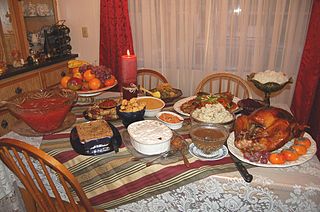 The first Thanksgiving was celebrated by the early settlers with help from the Native Americans as a way to offer thanks for their surviving another brutal year. They constantly lived with the uncertainty that there would be enough food and this relatively abundant spread was a rare treat for them.
The first Thanksgiving was celebrated by the early settlers with help from the Native Americans as a way to offer thanks for their surviving another brutal year. They constantly lived with the uncertainty that there would be enough food and this relatively abundant spread was a rare treat for them.
Thanksgiving has evolved into a holiday that revolves around family, food, and sometimes football. Now we don’t have to worry about having enough food to survive, we have to worry about surviving the over-abundance we have!
Not Your Ancestors’ Thanksgiving
The average number of calories in Thanksgiving dinner can reach 4,500 — along with 229 grams of fat. It contains nearly 200 grams of carbohydrates and 2,000 milligrams of sodium, more than is healthy to consume in an entire day. Our traditional Thanksgiving spread bears no resemblance to the original Thanksgiving.
Here are some of the things you wouldn’t have found at the first Thanksgiving – mashed potatoes, gravy, sweet potatoes, stuffing, cranberry sauce, green bean casserole, or rolls with butter. They didn’t have sugar, eggs, or dairy so there was no pumpkin pie with whipped cream topping.
What did they eat? Few records exist but accounts show they ate deer, wild fowl (possibly wild turkey), cod, bass, wheat, corn, and barley. There was no specific mention of fruits or vegetables. Other items native to the area that may have been on the menu include clams, mussels, lobster, eel, acorns, walnuts, chestnuts, squash, and beans. There were no alcoholic beverages. Dried wild berries, grapes, or plums may have finished off the meal. Probably not your idea of dessert!
How Much Can One Meal Really Hurt?
Most people convince themselves that they can afford to pig out “just this once” – after all, they’ve looked forward to this meal all year long! They’ve been waiting to eat those delicious dishes that are only prepared at Thanksgiving. And how much can one bad meal really hurt?
Hospitals report a surge in heart attacks around Thanksgiving. The high intake of fat and carbohydrates elevates triglyceride and cholesterol levels. The high sodium content raises blood pressure. The stress of traveling and dealing family adds additional strain the heart. These increase your chances of a heart attack or a stroke. The American Heart Association says if you have heart disease, a big Thanksgiving meal quadruples the risk of having a heart attack.
Massive amounts of gastric acid are produced trying to handle the load of food which can lead to several acid reflux. The high fat content has been known to precipitate a gallbladder attacks.
The average Thanksgiving dinner is could be dangerously high in carbohydrates for anyone with diabetes.
Even if you have no serious medical concerns, you’ll probably feel in need of a nap after eating. People blame the tryptophan in the turkey for making them tired, but there isn’t enough tryptophan in a serving of turkey to matter. It takes a tremendous amount of energy to digest so much food at once. While your stomach is hard at work digesting, it pulls blood supply away from other organs for up to six hours, leaving your heart and brain relatively deprived. That’s why you feel comatose after a huge meal.
Recipe for a Healthy Thanksgiving
Fortunately, you don’t have to eat a meal that resembles the first Thanksgiving to have a healthy holiday. Here some steps you can take to stay happy, healthy, and feeling great while enjoying the food you love.
- Eat a small breakfast and lunch. Starving yourself leads to overeating later.
- Take a walk earlier in the day. This stimulates enzyme production to help digest the meal.
- Offer healthier versions of a few side dishes. Have sweet potatoes roasted in olive oil as well as the marshmallow version.
- The resveratrol in red wine helps offset the side effects of a high fat meal. Have a glass or two, but no more. Getting tipsy leads to mindless overeating.
- Eat slowly and chew well. Savor each bite. You’ll eat less and enjoy it more.
- Be selective about what you eat. If you don’t love a particular dish, skip it.
- Keep the total amount of high carb foods on your plate to a portion the size of your fist. This may mean having only a tablespoon or two of some dishes.
- Stop eating when you are satisfied. Don’t go back for seconds of unhealthy food. If you are still genuinely hungry get more salad, turkey, or vegetables.
- Bring your own leftover containers to take home leftovers. Knowing you can have your favorite side dish again removes the need to gorge on it today.
- After eating, get up and move! Help clear the table, do the dishes, play with the kids, or take the dog for a walk. Plopping down in front of the TV is the worst way to finish off a day of heavy eating.
This isn’t an eating competition! Don’t eat like it’s your last meal, or it just may be. Every year people have fatal heart attacks after dinner, even people who weren’t aware they had an existing health problem.
Remember what Thanksgiving is really for — a celebration of gratitude for the abundance we are blessed with in all areas of our lives. It’s not just about food.
SOURCES:
Consumer Reports: Thanksgiving Dinner Can Be Deadly If You Overdo It at WashingtonPost.com
Does Eating Turkey Make You Sleepy? at Chemistry.About.com
How Much Sodium Is in Your Thanksgiving Meal? at Shape.com
Thanksgiving Dinner Nutrition Facts at SweetAdditions.com
The 1621 Thanksgiving at Mayflowerhistory.com
The Pilgrims’ Menu at History.com
This or That: What to Eat on Thanksgiving Day at Rodale.com
What Was on the Menu at the First Thanksgiving? at SmithsonianMag.com
 Deane Alban is co-founder of BeBrainFit.com where she teaches how to keep your mind sharp and your brain fit for the rest of your life. Deane holds a BA in biology and has taught and written about natural health topics for over 20 years.
Deane Alban is co-founder of BeBrainFit.com where she teaches how to keep your mind sharp and your brain fit for the rest of your life. Deane holds a BA in biology and has taught and written about natural health topics for over 20 years.
She writes a weekly newsletter to help if you suffer with poor memory, brain fog, or worry about “losing it” as you age that you can sign up for free at her website. You’ll also receive a copy of the original report – “Jumpstart Your Brain – Guide to a Better Memory.”
_____________
Copyright © 2012 Deane Alban. This article is published by HelpingYouCare® by permission and license from the author. All rights reserved.












Recent Comments from our Online Community